Related Research Articles

Booker Taliaferro Washington was an American educator, author, orator, and adviser to several presidents of the United States. Between 1890 and 1915, Washington was the dominant leader in the African-American community and of the contemporary Black elite. Washington was from the last generation of Black American leaders born into slavery and became the leading voice of the former slaves and their descendants. They were newly oppressed in the South by disenfranchisement and the Jim Crow discriminatory laws enacted in the post-Reconstruction Southern states in the late 19th and early 20th centuries.

William Edward Burghardt Du Bois was an American sociologist, socialist, historian, and Pan-Africanist civil rights activist. Born in Great Barrington, Massachusetts, Du Bois grew up in a relatively tolerant and integrated community. After completing graduate work at the Friedrich Wilhelm University and Harvard University, where he was the first African American to earn a doctorate, he became a professor of history, sociology, and economics at Atlanta University. Du Bois was one of the founders of the National Association for the Advancement of Colored People (NAACP) in 1909.

East St. Louis is a city in St. Clair County, Illinois. It is directly across the Mississippi River from downtown St. Louis, Missouri, and the Gateway Arch National Park. East St. Louis is in the Metro-East region of Southern Illinois. Once a bustling industrial center, like many cities in the Rust Belt, East St. Louis was severely affected by the loss of jobs due to the flight of the population to the suburbs during the riots of the late 1960s. In 1950, East St. Louis was the fourth-largest city in Illinois when its population peaked at 82,366. As of the 2020 census, the city had a population of 18,469, less than one-quarter of the 1950 census and a decline of almost one third since 2010.
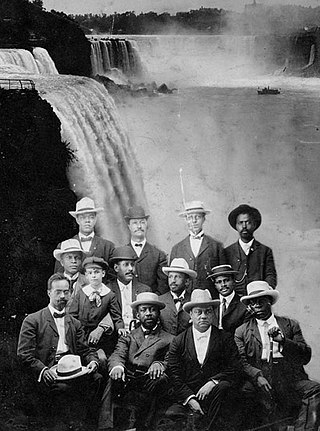
The Niagara Movement (NM) was a black civil rights organization founded in 1905 by a group of activists—many of whom were among the vanguard of African-American lawyers in the United States—led by W. E. B. Du Bois and William Monroe Trotter. It was named for the "mighty current" of change the group wanted to effect and took Niagara Falls as its symbol. The group did not meet in Niagara Falls, New York, but planned its first conference for nearby Buffalo.
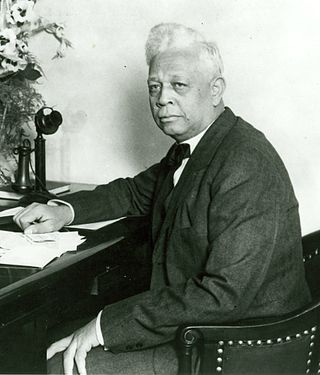
Oscar Stanton De Priest was an American politician and civil rights advocate from Chicago. A member of the Illinois Republican Party, he was the first African American to be elected to Congress in the 20th century. During his three terms, he was the only African American serving in Congress. He served as a U.S. Representative from Illinois's 1st congressional district from 1929 to 1935. De Priest was also the first African-American U.S. Representative from outside the southern states and the first since the exit of North Carolina representative George Henry White from Congress in 1901.
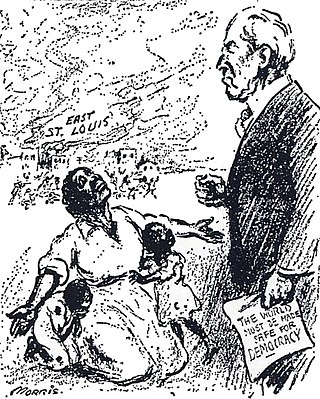
The East St. Louis massacre was a series of violent attacks on African Americans by white Americans in East St. Louis, Illinois between late May and early July of 1917. These attacks also displaced 6,000 African Americans and led to the destruction of approximately $400,000 worth of property. They occurred in East St. Louis, an industrial city on the east bank of the Mississippi River, directly opposite the city of St. Louis, Missouri. The July 1917 episode in particular was marked by white-led violence throughout the city. The multi-day rioting has been described as the "worst case of labor-related violence in 20th-century American history", and among the worst racial riots in U.S. history.
The civil rights movement (1896–1954) was a long, primarily nonviolent action to bring full civil rights and equality under the law to all Americans. The era has had a lasting impact on American society – in its tactics, the increased social and legal acceptance of civil rights, and in its exposure of the prevalence and cost of racism.
The National Negro Committee was created in response to the Springfield race riot of 1908 against the black community in Springfield, Illinois. Prominent black activists and white progressives called for a national conference to discuss African-American civil rights. They met to address the social, economic, and political rights of African Americans. This gathering served as the predecessor to the National Association for the Advancement of Colored People (NAACP), which was formally named during the second meeting in May 1910.
The Boston Guardian was an African-American newspaper, co-founded by William Monroe Trotter and George W. Forbes in 1901 in Boston and published until the 1950s.
What came to be known as the Atlanta Compromise stemmed from a speech given by Booker T. Washington, president of the Tuskegee Institute, to the Cotton States and International Exposition in Atlanta, Georgia, on September 18, 1895. It was first supported and later opposed by W. E. B. Du Bois and other African-American leaders.
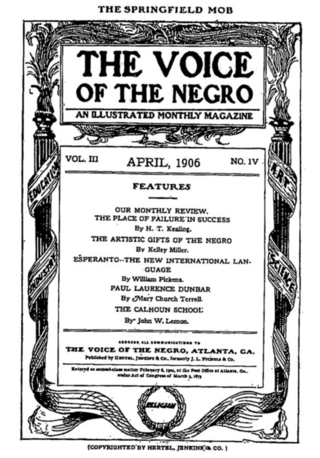
The Voice of the Negro was a literary periodical aimed at a national audience of African Americans which was published from 1904 to 1907. It was created in Atlanta, Georgia in June 1904 by Austin N. Jenkins, the white manager of the publishing company J. L. Nichols and Company. He gave full control of the magazine to the Black editors John W. E. Bowen, Sr. and Jesse Max Barber.
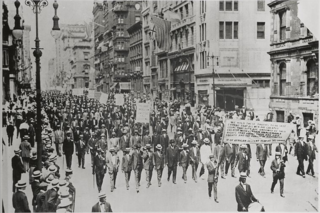
The Negro Silent Protest Parade, commonly known as the Silent Parade, was a silent march of about 10,000 African Americans along Fifth Avenue starting at 57th Street in New York City on July 28, 1917. The event was organized by the NAACP, church, and community leaders to protest violence directed towards African Americans, such as recent lynchings in Waco and Memphis. The parade was precipitated by the East St. Louis riots in May and July 1917 where at least 40 black people were killed by white mobs, in part touched off by a labor dispute where blacks were used for strike breaking.

Noah Walter Parden was an American attorney and politician who was active in Chattanooga, Tennessee, East St. Louis, Illinois, and St. Louis, Missouri between 1891 and 1940. In 1906 he became one of the first African-American attorneys to serve as lead counsel in a case before the United States Supreme Court, and he was among the first to make an oral argument before the Court. In 1935 he became the first African American to be appointed to the position of Assistant Prosecuting Attorney, a public office, in St. Louis.

East St. Louis Lincoln High School was a high school in East St. Louis, Illinois. It was established in 1909 as a school for blacks and consolidated with East St. Louis Senior High School in 1998.
Leroy Bundy (1883–1943) served as a city councilman in Cleveland from 1929 to 1937. Before serving as city councilman, however, Bundy, an African American, was accused of leading a mob that sparked the East St. Louis riots of July 2, 1917. Bundy was the last person to be tried out of 34 defendants, 20 of these defendants were white, and all of the defendants received imprisonment. Bundy served one year in prison and worked as a dentist while imprisoned. Following his release, Bundy became a city councilman and led the fight to block seating of delegates that excluded African Americans at the Republican National Convention in Cleveland.
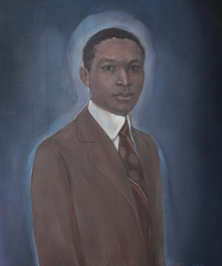
Homer Gilliam Phillips was an American lawyer from Sedalia, Missouri who moved to St. Louis. An African-American Republican political figure, he was a prominent advocate for civil rights. He was a co-founder of Citizen's Liberty League, a political organization in Missouri to advance the interests of African Americans in the Republican Party. In 1928, he was the president of the St. Louis chapter of the National Bar Association. In 1931, at 51 years old, Phillips was gunned down in St. Louis in an alleged dispute over legal fees owed to him. After his death, a hospital in St. Louis he helped organize was named in his honor, Homer G. Phillips Hospital.
The Chicago Conservator was an American newspaper. Founded by attorney Ferdinand Barnett in 1878, it was the first African-American newspaper in Chicago.

Woodrow Wilson (1856–1924) was the prominent American scholar who served as president of Princeton University from 1902 to 1910, as governor of New Jersey from 1911 to 1913, and as the 28th president of the United States from 1913 to 1921. While Wilson's tenure is often noted for progressive achievement, his time in office was one of unprecedented regression in racial equality.
May Childs Nerney was an American civil rights activist and librarian. She was the secretary of the NAACP from 1912 to 1916, overseeing a large increase in the organization's size. She led protests against the segregation of federal government employees in Washington, D.C., and against the film The Birth of a Nation (1915). Nerney came into conflict with several members of the organization and resigned in 1916. She later worked on cataloging Thomas Edison's papers and published a 1934 biography on him, Thomas A. Edison, A Modern Olympian. She also worked with the League of Women Voters, the board of the Young Women's Christian Association, the Consumers Cooperative Services, and the New York Philharmonic Society.
References
- ↑ "Elliott Rudwick". Encyclopedia Britannica.
- ↑ Wright, Paul M.; Smith, Earl; Aptheker, Herbert; Rudwick, Elliott (April 1, 1977). "Communications". The Journal of Negro History. 62 (2): 195–199. doi:10.1086/JNHv62n2p195. S2CID 224833436 – via journals.uchicago.edu (Atypon).
- ↑ "Letter from Elliot M. Rudwick to W. E. B. Du Bois, September 19, 1959". credo.library.umass.edu.
- ↑ "Deadly 1917 Riot Mostly Forgotten : Unrest: Seventy-five years before Los Angeles' disturbances, 48 died in East St. Louis racial attacks. A survivor says, 'It was just like war.'". Los Angeles Times. July 12, 1992.
- ↑ "Books of The Times End Papers RACE RIOT AT EAST ST. LOUIS. By Elliott M. Rudwick. 300 pages, Ill. Southern University of Illinois Press, Illinois. $6. (Published 1964)". July 24, 1964 – via NYTimes.com.
- ↑ "Elliott M. Rudwick, 58, Dies; Sociology Professor at Kent". The New York Times. 1986-01-13. Retrieved 2021-05-14.
- ↑ "John Simon Guggenheim Foundation | Elliott M. Rudwick".
- ↑ "Negro retaliatory violence / Dr. Elliot Rudwick. | Pacifica Radio Archives". www.pacificaradioarchives.org.
- ↑ The Niagara Movement
- ↑ "Rudwick, Elliott M. [WorldCat Identities]".
- ↑ Rudwick, Elliott M. (March 1, 1965). "FIFTY YEARS OF RACE RELATIONS IN EAST ST. LOUIS: THE BREAKING DOWN OF WHITE SUPREMACY". American Studies: 3–15 – via journals.ku.edu.
- ↑ Rudwick, Elliott M. (1962). "Race Leadership Struggle: Background of the Boston Riot of 1903". The Journal of Negro Education. 31 (1): 16–24. doi:10.2307/2294533. JSTOR 2294533 – via JSTOR.